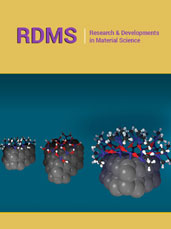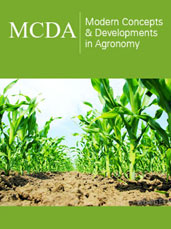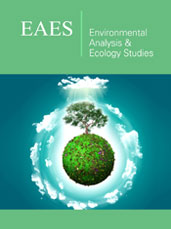- Submissions

Full Text
Novel Techniques in Nutrition and Food Science
Development of a shelf-stable, nutritious, additive-free instant fish soup powder
Aarti S Kakatkar1*#, Raj Kamal Gautam1#, Ashika Debbarma1, Vivekanand Kumar1,2, Prashant Kumar Mishra1 and Suchandra Chatterjee1,2*
1Food Technology Division, Bhabha Atomic Research Centre, Mumbai, India
2Homi Bhabha National Institute, Anushaktinagar, Mumbai, India
#Authors contributed equally
*Corresponding author:Aarti S Kakatkar, Food Technology Division, Bhabha Atomic Research Centre, Mumbai, India Suchandra Chatterjee, Food Technology Division, Bhabha Atomic Research Centre, India and Homi Bhabha National Institute, Anushaktinagar, Mumbai, India
Submission: October 21, 2024;Published: November 14, 2024

ISSN:2640-9208Volume8 Issue1
Abstract
Fish is an excellent nutritious source, but it is highly perishable, prompt processing of fish helps to retain its shelf-life and nutrient content. Soup is one of the oldest foods, used as an appetizer, prepared by combining ingredients such as vegetables, green leaves with juice, water or any other liquid. Vegetable and chicken-based soups are readily available, but fish-based soup is scarce. In the present study, an instant fish soup powder was prepared using one of the most relished marine fish varieties, Seer (Scomberomorus guttatus) and vegetables. Fish soup powder was prepared using a combination treatment of cooking followed by drying and packaging. The sample had a moisture content of (16.28%), water activity (0.411 at 31.8 °C), adequate protein (14.52%), carbohydrate (43.85%), dietary fibers (27.93g/100g), saturated fat (3.76g/100g), Mono-Unsaturated Fatty Acids (MUFA) (10.53g/100g), poly-Unsaturated Fatty Acids (PUFA) (2.94g/100g) and absence of trans-fat. Periodic microbiological, biochemical, organoleptic and nutritional analysis showed that the product was acceptable for 12 months on storage at room temperature with negligible microbial growth (0.96 logcfu/g) at the end of 12 months. Thus, the developed instant fish soup powder is a convenient, ready to cook, easy to carry, shelf-stable and a nutritious whole food which can be consumed by all, specialized consumer groups (obese, diabetics, elderly, kids) and can be readily used for military ration or during emergency food during natural disaster. This can also be integrated with the meal supplied through Integrated Child Developmental Schemes (ICDS) (Graphical Abstract).
Figure 1.Graphical Abstract

Keywords:Seer fish; Fish soup powder; Shelf-life; Nutritious; MUFA; PUFA
Introduction
Soup is probably the oldest food prepared by a combination of various ingredients that are easily digestible and served as “complete food” in a single pot. This preparation could also be adjusted according to individuals’ dietary needs like low salt, high fiber, etc. [1]. Development in technologies in the 19th century improved the soups from a liquid state to a dehydrated state which could be conveniently supplied as military rations, in wagon/train pantries as well as at home. Nowadays the 20th “century instant soups” are dehydrated soup powders that are gaining popularity because of their easy and quick transport, storage and preparation methods suitable for consumers with long working hours. Drying is the oldest method of food preservation. Hot air drying and freeze drying are older methods but require a longer time, consume lots of energy and may deteriorate the quality of the product. Infra-red drying is popular today because it requires shorter heating time. There is uniform heating of food material therefore, quality loss is less, no migration of solute in the food content takes place and substantial energy savings compared to traditional methods [2-4]. Additionally, the growing proportion of the working population and a busy, hectic (on-the-go) lifestyle have increased the demands for Ready-To-Cook (RTC)/Ready-To-Eat (RTE)/instant but complete meals. Closing restaurants has probably forced people to consume ready-to-eat frozen pizzas or instant food during the latest COVID-19 pandemic worldwide. Therefore, instant soups have gained importance because of their simple and fast preparation methods. Amongst the different geographical regions of North America, South America, Asia-Pacific and Europe, North America held the largest (47%) share of the soup market. The global market for instant soup powder increased by 5.1% value Compound Annual Growth Rate (CAGR) during the assessment year 2018 to 2022 as the pandemic increased the household consumption of instant soup which further increased to 5.5% in 2023 with a market value of 7639 Million USD and projected to reach a value of 12,941 Million USD by 2033 [5] Out of these demand for animal-based soups especially chicken soup has been increasing with a market value of 3866 Million USD in 2023 and a projected increase to a market value of 5968 Million USD by 2033. According to a statistical report [6]. India is at the 16th position in the demand for instant soup powder with a market value of 0.69 billion USD in 2023 which would grow annually with a CGAR of 7.7% by 2028.
The consumers today prefer fresh, preservative-free soup
which must be a complete meal. Soups with monosodium glutamate
or high sodium content or canned soup with a lining of bisphenol
or bisphenol A, an endocrine disruptor are not preferred [7]. The
innovative ideas in the non-vegetarian soups have increased the
demand for soups with chicken and seafoods. Chicken soups are
easily available, but fish soup is scarce. The objective of the present
work was:
A. To prepare instant fish soup using a popular fish and vegetables
that was free of any preservatives/additives.
B. To extend the shelf-life of this soup powder on storage at room
temperature using the combination of hurdles like cooking,
drying and packaging.
Material and Methods
Fish, vegetables and other raw materials
Chilled fresh fish (seer fish-Scomberomorus guttatus) beheaded, eviscerated and deboned and fresh vegetables like carrots, French beans, ginger, garlic, green chilli, coriander were procured from local market. Soy sauce, vinegar, corn starch and refined vegetable oil were procured from the local market.
Preparation of fish soup powder
The vegetables were cleaned and chopped finely. Fish meat (100%w/w), carrot (26%w/w), mushroom (26%w/w) and French beans (26%w/w) were steamed and the stock obtained was kept separately. Finely cut onion (26%w/w), ginger (20%w/w), garlic (20%w/w), chili (2.4%w/w) were sautéed with soy sauce 4%w/v and vinegar 2%w/v; this was followed by addition of salt 4%w/w, pepper powder 2%w/w and previously prepared stocks (vegetable and fish). This mixture was boiled to cook. The stock steamed vegetable and fish stocks were dried separately in Infra-Red (IR) dryer for 6h at 60 °C. The dried soup stock was collected and powdered in homogenizer and corn starch added to the mixture.
Chemicals and media
All the chemicals of analytical grade were purchased from SISCO Research laboratories Pvt. Ltd. India (SRL). The media for microbiological analysis were procured from HI media Laboratories Pvt. Ltd., India (HI Media).
Packaging and storage studies
The fish soup powder was packed in stand-alone pouches (Trend Plast Pouch Pack Private Limited, Mumbai) and were stored at an ambient temperature. The sample was periodically analyzed for quality and acceptance by nutritional microbiological, biochemical and organoleptic analysis.
Proximate analysis
The proximate analysis in terms of moisture, fat, protein and
ash content of dried soup powder was evaluated as per AOAC. The
carbohydrate and energy content were calculated by the formulae
given below:
Carbohydrate content (%) = [100-(Protein (%)+Fat
(%)+Moisture(%)+Ash (%)]
Energy (kcal) = 4 [(protein(g) + carbohydrate(g)] + 9 [fat (g)]
Nutritional analysis
The nutritional composition of fish soup powder on 0 day and end of storage period was validated through National Accreditation Board for Testing and Calibration Laboratories (NABL) certified laboratory (Ram Krishna Bajaj CFBP consumer education and testing center, Mumbai, India).
Free fatty acid composition analysis
The oil from soup powder was extracted as described earlier [8]. Briefly, the powder (1:5w/v) was mixed well with solvent [chloroform and methanol (2:1v/v)] using rotary shaker (Infor’s HT, Switzerland) at 100rpm for 3-4 h and then left undisturbed for 24h. After 24h the extract was filtered and then concentrated using rotary evaporator (Equation medica, Roteva 3.0, India) at 40 °C. To esterify the fish oil methanol and 2N potassium hydroxide was used as described [9]. The Fatty Acid Methyl Esters (FAME) were analyzed by injecting (0.5μl volume with 1mg/ml concentration and 1:70 split ratio) in a GC-MS (QP-2020, Shimadzu, Corporation, Kyoto, Japan). The FAME mass fragmentation patterns were then compared with the standard spectra in the library (Wiley/NIST).
Microbiological analysis
The fish soup powder was analyzed for Total Bacterial Count (TBC), Total yeast and Mold Count (TMC) as per [10,11]. Shortly 10% of appropriately diluted sample was plated on plate count agar and rose Bengal chloramphenicol agar and incubated at room temperature for 48h and 7 days to estimate TBC and TMC respectively. For detection of food borne pathogen Salmonella and coagulase positive Staphylococcus aureus methods described earlier were used [10]. Shortly, Salmonella species were analyzed by pre- enrichment of 10% soup powder homogenate in buffered peptone water, enrichment in Rappaport Vassiliadis broth and plating on selective plates. Typical colonies were picked for battery of biochemical tests and the presumptive positive colonies were confirmed by PCR test using invA gene primer [11]. To detect S. aureus appropriate dilution from 10% homogenate from buffered peptone water was spread plated on Baird Parker’s agar plate and incubated at 37 °C for 24h; typical black colored colonies with halo zone were picked up confirmed by coagulase test using 2% rabbit plasma [10,12].
Biochemical analysis
The freshness index was measured in terms of Total Volatile Basic Nitrogen (TVBN) released was determined by Conway micro diffusion method and expressed in terms of mg N/100g [13,14]. The lipid peroxidation in terms of Thio Barbituric Acid Reactive Substances (TBARs) was determined and the results were expressed as microgram malonaldehyde/gram (μg MDA/g) of sample using a factor of as per [14,15].
Organoleptic analysis
Fish soup powder (5g) was added to 100ml of potable boiling water to prepare instant soup for organoleptic analysis. Analysis was carried out in a taste panel laboratory in partitioned compartments by 10 trained panelists (5 males and 5 females aged between 25-59 yrs.) using 9-point hedonic scale (9-like extremely, 8-like very much, 7-like moderately, 6-like slightly, 5-neither liked nor dislike, 4-dislike slightly, 3-dislike moderately, 2-dislike very much, 1-dislike extremely) based on following sensory parameters like appearance, colour, texture, odour, taste, after-taste and overall acceptability. The scores were averaged, and the results were expressed as web diagram for all parameters.
Statistical analysis
All the experiments were performed in triplicate and repeated thrice independently (n=9). The data expressed as Mean ± Standard deviation. Analysis of variance (ANOVA) and Duncan’s multiple comparison test was performed using the software DSAASTAT at p<0.05 [16].
Results and Discussion
A homogenized instant fish soup powder (Figure 1a) was reconstituted using boiling water (Figure 1b).
Figure 2.a) Ready to boil instant soup powder prepared after mixing all the ingredients.
b) The reconstituted soup prepared by boiling 5% of powder in potable water.

Proximate and nutritional analysis
Table 1 depicts the proximate and nutritional composition of instant fish soup powder. The instant fish soup powder had a moisture content of 16.28% with water activity (aw) 0.411 at 31.5 °C. This higher moisture is similar to that reported by a soup prepared using silver carp and vegetable soup [17,18] but lower than dried fish-cereal soup [19]. Moisture content is an important parameter for food preservation. The conventional solar drying is still largely practiced for preservation of vegetables and fish, depends on weather conditions and may lead to spoilage before the required drying. Use of hot air-drying compromises with the product quality as it causes discoloration, shrinkage and loss of nutrients. IR drying is advantageous because in this process the heat energy is transferred to the product without heating the surrounding air, leading to faster and uniform drying of the product [20]. The use of IR dryer in the present study has helped in uniform drying of the fish meat and vegetables as well as to preserve its flavor and aroma.
Table 1:Proximate and nutritional analysis of instant fish soup powder.

ND*-Not detected.
The results shown are Mean ± Standard deviation of 3
independent experiments in triplicates (n=9).
Fish is a nutritious seafood preferred because of its easily digestible protein and essential fatty acid content. The soup prepared from Seer fish meat had a protein, fat content of 14.52 and 17.24% respectively. Similar protein (16.1%) and total fat (10.4%) content has been reported for a freshwater catfish Clarias Garie Pinus [21]. The total fat content was higher than that obtained for soup powders which contained silver carp (9.25%), rainbow trout (7.87%), sea bream (5.80%), sea bass (5.61%) [22,23] but equivalent to the soup prepared using whole fish powders from Clarias gariepinus (10.4%) and pink perch, Nemipterus japonicus (11.5%). The total mineral content of the instant fish soup powder represented by its ash content (8.11%) and the total carbohydrate content (43.85%) is equivalent to the earlier reports for instant fish soup mix reported earlier for catfish, silver carp, pink perch [17,21,24]. The total dietary fiber content of the dehydrated soup was 27.93%, which was comparable with total dietary fiber content (30.8%) of the soup prepared using tilapia fish for elderly [25]. The absence of trans-fat and lower cholesterol is also beneficial to the diet restricted/conscious consumers [17].
Free fatty acid profile of fish soup powder
Table 2:Free fatty acid profile of instant fish soup powder.

The data are expressed as percentages of total Fatty Acid Methyl Esters (FAMEs).
The fatty acid profile showed 19 different fatty acids (Table 2) with presence of saturated fatty acids- tetra decanoic acid (0.4%), hexadecenoic (9.72%), octadecenoic (5.04%), eicosanoic acid (0.44%), docosanoic (1.05%), tricosanoic (0.66%) and tetracosanoic (0.43%). The monounsaturated fatty acids-9-hexadecenoic acid (0.64%), 6 octadecenoic (19.45), cis-11 ecosinoic (0.29), 13 dococenoic (0.04%), 15-tetracosenoic (0.15%). The profile showed the highest percentage of linoleic acid (9,12-Octadecadienoic acid; > 60%) which is one of the essential polyunsaturated fatty acids, other essential fatty acids ecosapentaenoic acid and docosahexaenoic acid are also observed. These essential fatty acids are widely known to be present in seafood. World health organization has recommended that an adult must consume 10% of linoleic acid daily as energy source [26]. Ecosapentaenoic acid and docosahexaenoic acid are precursors of eicosanoids required for the improvement of cardiovascular, inflammatory irregularities, brain functions [27]. The ratio of ω-6 to ω-3 often depends on the diet of the fish. In the present study Seer fish was used to prepare soup which feeds on small pelagic fishes like anchovy, which is a plankton eater, therefore, the PUFA content in Seer fish is higher than MUFA; processing has not affected the PUFA content and the soup prepared is also high in PUFA content [28]. The odd chain of essential fatty acids pentadecanoic and heptadecanoic important in fighting against global pandemics of cardiometabolic diseases, obesity and nonalcoholic steatohepatitis are also present; approximately 200mg/day of these are required for maintaining healthy metabolic state in human beings [29]. Earlier researchers have studied the fatty acid profile of different fish from different regions; however, nowadays the fish is used to make value added product and it is essential to analyze the nutritional and fatty acid content of the product developed. The studies show the fish soup powder is nutritionally adequate.
Microbiological analysis
A negligible increase in the microbial count of samples from 1.69 to 2.65 logcfu/g was observed when stored at room temperature for 18 months (Figure 2). No yeast and mold growth were observed during the entire storage period. The [30] limit for total microbial count and total yeast and mold count is 6 logcfu/g and 4 logcfu/g respectively. A similar increase in microbial load was observed in a ready to cook soup with pink perch by-product [24]. An increase in the total mesophilic aerobic bacteria (1.5x104 cfu/g) was observed in carp soup on 60th day of storage while a soup prepared using anchovy showed an increase from 2.23 logcfu/g to 6.1 logcfu/g in 6 months while an increase in total mold counts has also been reported to 102 cfu/g by researchers for fish soups produced using sardine or combination of fish species stored at ambient temperature [23,31,32]. Food borne pathogens Salmonella and coagulase positive S. aureus were not detected in instant fish soup powders. Salmonella is a zero-tolerant organism according to many food authorities (FSSAI, USFDA, European Commission). It can survive dry environment or low moisture food for years [33]. Recently, a beef soup mix had been recalled from the market due to possible contamination of Salmonella [34]. The presence of S. aureus is indication of bad manufacturing and handling practices during food processing or may be due to a contaminated unprocessed product [35]. Analysis of total microbial load depends on the raw materials used and vessels used during preparation of the product. In the present study steaming of Seer fish and steaming/sautéing of vegetables has decreased the initial microbial load and approximately only one log cycle increase is observed during entire storage period of 18 months.
Figure 3.Total bacterial count of instant fish soup powder mixes on storage at ambient temperature. It is seen that the initial total bacterial count of 1.69 logcfu/g increased only by one log cycle to 2.65 logcfu/g when stored at ambient temperature for 18 months which is within the limit of 6 logcfu/g set by food safety and standardization authority of India (FSSAI 2016).

Biochemical analysis
TVBN and TBARS are biochemical analysis which give an idea about freshness of and lipid peroxidation in fishery products. Volatile amines are responsible for peculiar fishy odour and flavor which may increase on storage. The initial TVBN values of fish soup powder was 31.7 ± 0 which increased to 95.47mgN% at the end of storage period of 18 months (Table 3). Instant soup powder is prepared using Seer fish which has been steamed and dried. Therefore, the increased TVBN is probably due to autolytic degradation during drying. Similar higher TVBN values with low microbial load have been reported previously for semi dried shrimp, fermented dried fish, solar dried fish earlier [36-39]. The TVBN values in the present analysis are well below the limit set for dried fish salted with 10% salt (between 100-200mgN%) as suggested [40,41]. TBARS assay is used to assess lipid oxidation. This is the most popularly used indicator which measures the end-product of lipid oxidation malonaldehyde [42]. In the present study the initial TBARS value was 3.29μg MDA/g which increased gradually to 7.75μg MDA/g after 18 months during storage (Table 3). Higher initial TBARS values may be due to oxidation of unsaturated fatty acids to low molecular weight carbonyls on drying. These values were similar to higher TBARS reported for intermediate moisture shrimp as well as dried yellow corvenia [36,43]. The other components in the dried vegetables or fish like fish muscle, nucleotides, nucleic acids, proteins may cause fluctuations in TBARS intermittently during storage on interaction with malonaldehyde as reported for boiled Seer fish [44].
Table 3:Biochemical analysis of fish soup powder on storage at room temperature.

The results shown are Mean±Standard deviation of 3 independent experiments in triplicates(n=9).
Organoleptic analysis
Organoleptic analysis in terms of appearance, odour, taste, flavour, mouthfeel, texture, etc. are important in the overall acceptability of any product by a consumer [45]. The instant fish soup powders were microbiologically safe for up to 18 months however, the samples were not accepted by taste panelists after 12 months of storage at room temperature on 9-point hedonic scale (Figure 3). Organoleptic analysis of fish soups also revealed that the samples were more acceptable initially with a score of 7.09 till 4 months of storage at ambient temperature. The sensory scores decreased in the 6th month (6.83) and further were unacceptable at 18th month of storage (4.89) by trained taste panelist (Figure 3). The organoleptic analysis guides the researchers to determine food quality from consumers’ perception therefore it is the most important parameter to be studied. The factors like psychology, society, culture, religion, climatic variation, physical state of an individual determines the organoleptic properties. The volatile and non-volatile components present as ingredients in the soup powder are responsible for imparting flavour to the soup which leads to its widespread consumption [46]. Free amino acids, soluble sugars and small molecular weight water soluble 5-nucleotides are mainly responsible for the taste; however, palatability and selfsatisfaction of an individual is important. In many soups powders taste enhancer like Mono Sodium Glutamate (MSG) is added; but this is known to have many adverse side effects unless added within GRAS limits [17,21,24,47]. It is known to be a neurotransmitter and may cause metabolic anomalies in human beings when consumed with high lipid diets. In the present study the taste of soup powder is imparted by the use of fresh vegetables and Seer fish. No MSG, chemical preservatives, artificial colours and stabilizers are added therefore it is safer than the soups available in the markets. Therefore, soup prepared in the present formulation is more favorable as it is nutritionally adequate and without addition of any preservatives.
Figure 4.Overall acceptability of instant fish soup powder on 9-point hedonic scale on storage at ambient temperature. The line (-) indicates acceptable limit. Different letters on the error bars indicate significant differences (p<0.05).

Cost effectiveness of the instant fish soup powder
The soup powder is prepared using seer fish and vegetables like carrot, beans, mushrooms which are locally available. It has no added preservatives and can be stored in packed powder form until use for 12 months at ambient temperature, therefore, it is cost effective compared to the soups available in the local markets. Moreover, any locally available fish can be used.
Conclusion
Instant fish soup powder prepared using a popular fish, fresh veggies are nutritionally adequate and microbiologically safe for 18 months at room temperature. However, the organoleptic qualities deteriorated at 12 months therefore we restrict its shelf-life for 12 months. The instant fish soup powder is preservative free and does not contain trans-fat, so it is a good source of healthy, easy to prepare drink, a boon especially for diet conscious individuals with hectic workstyle, college going students away from home as well as common man.
Acknowledgement
The authors acknowledge Mr Shabbir Alam for technical help.
Author Contributions
ASK and RKG contributed equally to Formal analysis (equal); investigation (equal); methodology (equal); writing-original draft (equal); AD validation; writing – review and editing; VK contributed in methodology; resources; validation; PKM Formal analysis; validation; writing-review and editing; SC Conceptualization; project administration; supervision. All the authors read and approved the final manuscript.
Statements and Declarations
Conflict of interest
The authors declare that they have no known competing financial interests or personal relationships that would influence the work reported in this paper.
Animal and human rights statement
Chilled fresh fish (seer fish-Scomberomorous guttatus) beheaded, eviscerated and deboned were purchased from local market in deceased condition. Participants (Sensory panelists) gave informed consent via the statement “I am aware that my responses are confidential, and I agree to participate in this survey” where an affirmative reply was required to enter the survey. They were able to withdraw from the survey at any time without giving a reason. The products tested were safe for consumption.
Funding sources
This research did not receive any specific grant from funding agencies in the public, commercial, or not-for-profit sectors.
Data availability
The technology (AB42FTD) is available for transfer on BARC website: https://barc.gov.in
References
- Toussaint-Samat M (2009) In: A history of food, New expanded ed., 2 ed. Wiley-Blackwell, Chichester, West Sussex, U.K Malden, MA.
- Priti, Prameela K (2020) Formulation, nutritional, sensory, antioxidant activity and shelf life studies of instant soup mix. Int J Pharm Sci Res 11(12): 6114-6123.
- Huang D, Yang P, Tang X, Luo L, Sunden B et al. (2021) Application of infrared radiation in the drying of food products. Trends Food Sci Technol 110: 765-777.
- Shahi S, Khorvash R, Goli M, Ranjbaran SM, Najarian A, et al. (2021) Review of proposed different irradiation methods to inactivate food-processing viruses and microorganisms. Food Sci Nutr 9(10): 5883-5896.
- (2024) Persistence Market Research, https://www.persistencemarketresearch.com Market Research Reports, Industry Analysis & Business Insights | Persistence Market Research (PMR) In: Persistence Market Research.
- Mujumdar AS (2007) In: Handbook of Industrial Drying Taylor & Francis eB
- (2024) Industry ARC 2024 https://www.industryarc.com/Report/18044/soup-market.html Soup Market Size Report, 2022-2027. Accessed 11 Apr 2024 .
- Debbarma A, Kumar V, Mishra PK, Kakatkar AS, Gautam RK, et al. (2023) Valorisation of Basa fish (Pangasius bocourti) waste: Oil extraction and encapsulation. Int J Food Sci Tech. 58(5): 2764-2771.
- Ichihara K, Shibahara A, Yamamoto K, Nakayama T (1996) An improved method for rapid analysis of the fatty acids of glycerolipids. Lipids 31(5): 535-539.
- Kakatkar A, Gautam R, Nagar V, Karani M, Bandekar JR et al. (2010) Incidence of food-borne pathogens in freshwater fish from domestic markets of Mumbai. Fishery Technol 47(2): 207-212.
- Bacteriological Analytical Manual (BAM) (2024) https://www.fda.gov/food/laboratory-methods-food/bacteriological-analytical-manual-bam. Accessed 30 May 2024.
- Chiu CH, Ou JT (1996) Rapid identification of salmonella serovars in feces by specific detection of virulence genes, invA and spvC, by an enrichment broth culture multiplex PCR combination assay. J Clin Microbiol 34(10): 2619-2622.
- Farber L, Ferro M (1956) Volatile reducing substances and volatile nitrogen compounds in relation to spoilage in canned fish. Food Technol 10(7): 303-304.
- Kakatkar AS, Gautam RK, Mishra PK, Kumar V, Debbarma A, et al. (2022) Development of nutritious ready to eat fish spread from Harpodon Nehereus and its shelf-life extension using gamma irradiation. J Biotechnol Biores 3(5): 1-6.
- Witte VC, Krause GF, Bailey ME (1970) A new extraction method for determining 2-thiobarbituric acid values of pork and beef during storage. J Food Sci 35(5): 582-585.
- Kakatkar AS, Kumar V, Debbarma A, Mishra PK, Gautam RK, et al. (2024) Valorization of basa (pangasius bocourti) fish waste to prepare safe pet food and its shelf-life extension using gamma irradiation. Waste Biomass Valor 15: 4647-4656.
- Rahman MA, Saifullah M, Islam MN (2012) Fish powder in instant fish soup mix. J Bangladesh Agric Univ 10(1): 145-148.
- Farzana T, Mohajan S, Saha T, Hossain NM, Haque ZM, et al. (2017) Formulation and nutritional evaluation of a healthy vegetable soup powder supplemented with soy flour, mushroom and moringa leaf. Food Sci Nutr 5(4): 911-920.
- Basu S (1990) Dried fish-cereal mixture. Fishery Technol 27(2): 162-163.
- Guiné RPF (2018) The drying of foods and its effect on the physical-chemical, sensorial and nutritional properties. Int J Food Engg 4(2): 93-100.
- Bothma C, Cronjé N, Koen M, Hugo A (2020) Product development and consumer acceptability of soup made from clarias gariepinus. CyTA-J Food 18(1): 572-579.
- Zhang G, Zheng S, Feng Y, Shen G, Xiong S, et al. (2018) Changes in nutrient profile and antioxidant activities of different fish soups, before and after simulated gastrointestinal digestion. Molecules 23(8): 1965.
- Öztürk F, Kalkan S, Elmas E, Elmas S, Bariş P, et al. (2019) Some quality parameters of powdered soups prepared from different fish species. Braz Arch Biol Technol 62: e19180365.
- Kumari A, Kaushik N, Slizyte R, Khushboo (2023) Formulation of a ready-to-cook soup mix using microencapsulated protein hydrolysate obtained from pink perch by-product. Pol J Food Nutr Sci 73(3): 253-264.
- Sinchaipanit P, Sangsuriyawong A, Visetchart P, Nirmal NP (2023) Formulation of ready-to-eat soup for the elderly: nutritional composition and storage stability study. Foods 12(8): 1680.
- Jandacek RJ (2017) Linoleic acid: A nutritional quandary. Healthcare (Basel) 5(2): 25.
- Lekjing S, Venkatachalam K, Wangbenmad C (2021) Biochemical evaluation of novel seabass (Lates calcarifer) fish essence soup prepared by prolonged boiling process. Arab J Chemistry 14(10): 103365.
- Gaffari SM, Khoshnood Z (2021) Comparative study of the fatty acid composition of five freshwater fish species from the region of Dezful, Iran. Food Sci Appl Biotechnol. 4(1): 57-62.
- Venn WS, Lumpkin R, Dennis, EA (2020) Efficacy of dietary odd-chain saturated fatty acid pentadecanoic acid parallels broad associated health benefits in humans: Could it be essential? Sci Rep 10: 8161.
- FSSAI (2016) Manual for analysis of fish and fish products and meat and meat products. Food Safety Standard Authority of India 4: 49-51.
- Udari AHGS, Wickramasinghe I, Attygalle MVE (2015) Development of an omega 3 enriched instant soup powder from sardinella longiceps. Int J of Engg Sci Res Techn 4(8): 644-652.
- Kılınç B (2010) Preparation of liquid anchovy (Engraulis encrasicholus) soup and microbiological and sensory changes during refrigerated storage. J Muscle Foods 21(3): 451-458.
- Hayman MM, Edelson MSG, Carter PJ, Chen YI, Metz M, et al. (2020) Prevalence of cronobacter spp. and salmonella in milk powder manufacturing facilities in the United States. J Food Prot 83(10): 1685-1692.
- CDC Centre for disease and control Salmonella Outbreak Linked to Dry Dog Food.
- Guirguis E, Farag M (2017) Microbiological and sensory evaluation of instant vegetable stock from by-products of frozen food companies compared with the commercial stock cubes in Egypt. Bull National Nutri Inst the Arab Republic Egypt 48(1): 1-15.
- Gautam RK, Kakatkar AS, Mishra PK, Kumar V, Chatterjee S, et al. (2021) Development of shelf-stable, Ready to Cook (RTC) Intermediate Moisture (IM) shrimp and its shelf life extension using hurdle technology. J Agri Food Res 6: 100199.
- Kwon JH, Kausar T, Noh JE, Warrier SB, Venugopal V, et al. (2004) Inter-country transportation of irradiated dried Korean fish to prove its quality and identity. Radiat Phys Chem 71(1-2): 83-87.
- Sapkale P, Basu S, Warrier SB (2003) Storage characteristics of solar-dried indian mackerel. Indian J Fish 30: 165-471.
- Idakwo PY, Negbenebor CA, Badau MH, Gbenyi DI (2016) Total Volatile Base Nitrogen (TVBN) and Tri Methyl Amine (TMA) content of “Bunyi youri” as influenced by the addition of glucose and clove during storage. Int J Biotechnol Food Sci 4(5): 81-85.
- Connell JJ (1990) Methods of assessing and selecting for quality. Control of Fish Quality, 4th Edition. Fishing News Books, Wiley, Oxford, pp 240.
- Fernández J, Pérez ÁJA, Fernández LJA (1997) Thiobarbituric acid test for monitoring lipid oxidation in meat. Food Chem 59(3): 345-353.
- Gwak HJ, Eun JB (2010) Changes in the chemical characteristics of gulbi, salted and dried yellow corvenia, during drying at different temperatures. J Aquat Food Prod Technol 19(3-4): 274-283.
- Rajaram R, Maruthamuthu A, Metillo E (2017) Fatty acid profiling of commercially important raw and boiled seer fish Scomberomorus commerson (lacePede, 1800) (Scombridae, Teleostei, Pisces). Proc Zool Soc 71: 146-152.
- Ruiz CC, Herrero AM (2021) Sensory analysis and consumer research in new product development. Foods 10(3): 582.
- El Sayed SM (2008) Comparison between some processed dried soup products. Alex Sci Ex J 29: 130-144.
- Zanfirescu A, Ungurianu A, Tsatsakis AM, Nițulescu GM, Kouretas D, et al. (2019) A review of the alleged health hazards of monosodium glutamate. Compr Rev Food Sci Food Saf 18(4): 1111-1134.
- Banerjee A, Mukherjee S, Maji BK (2021) Worldwide flavor enhancer monosodium glutamate combined with high lipid diet provokes metabolic alterations and systemic anomalies: An overview. Toxicol Rep 8: 938-961.
© 2024 Aarti S Kakatkar and Suchandra Chatterjee. This is an open access article distributed under the terms of the Creative Commons Attribution License , which permits unrestricted use, distribution, and build upon your work non-commercially.
 a Creative Commons Attribution 4.0 International License. Based on a work at www.crimsonpublishers.com.
Best viewed in
a Creative Commons Attribution 4.0 International License. Based on a work at www.crimsonpublishers.com.
Best viewed in 







.jpg)






























 Editorial Board Registrations
Editorial Board Registrations Submit your Article
Submit your Article Refer a Friend
Refer a Friend Advertise With Us
Advertise With Us
.jpg)






.jpg)














.bmp)
.jpg)
.png)
.jpg)










.jpg)






.png)

.png)



.png)






